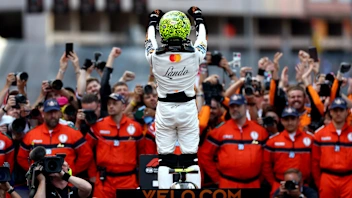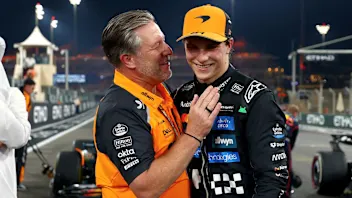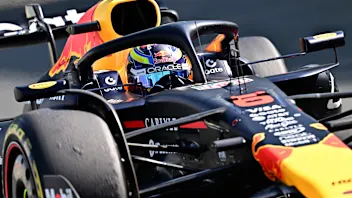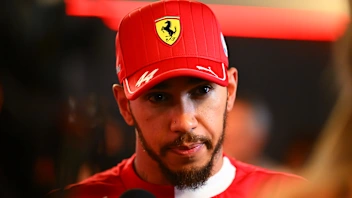Formula One racing's Swedish connection
When Marcus Ericsson was announced as one of Caterham’s drivers for the 2014 season, he wasn’t just fulfilling a lifelong ambition, he was also adding to Sweden’s proud history in Formula One racing.
In Australia next month, Ericsson will become the tenth driver from the Scandinavian country - and the first since 1991 - to start a Grand Prix. But just who were the other nine? Read on to find out…
Jo Bonnier
Stockholm-born Joakim Bonnier - better known as Jo - honed his skills ice racing in his homeland before going on to carve out a Formula One career that spanned three decades and more than 100 Grands Prix. His first world championship race - and the first for a Swede - came in 1956 when he took over Luigi Villoresi’s Maserati 250F in Italy. He raced the same model with limited success over the next two seasons before joining BRM at the tail end of 1958. The following year he would seal his place in motor racing history by scoring the British marque’s first Grand Prix victory at Zandvoort, but though he continued entering F1 races all the way through to 1971, it would prove to be the only podium finish of his career. Sadly, the year after his final F1 race he lost his life in a sportscar crash at Le Mans.
Ronnie Peterson
A quiet man off the track, Ronnie Peterson favoured letting his driving do the talking. Regarded by many as the outright quickest driver of the 1970s, the blond-haired racer exhibited the kind of spectacular sideways driving style that made him a fan favourite. Sadly, though, Peterson was never able to win the world championship that his deft car control merited. He entered the F1 arena with March in 1970, but it was when he joined Team Lotus in 1973 that his star really began to shine. Behind the wheel of the formidable Lotus 72 he scored four wins that year, and three more the following season. As Lotus’s competitiveness dwindled, Peterson secured a switch back to March in early ’76 and scored a brilliant victory in Italy, but he wouldn’t win again until he rejoined Lotus in 1978 after a disastrous ‘77 season driving Tyrrell’s six-wheeled P34. Despite playing a support role to team mate and eventual champion Mario Andretti, Peterson picked up wins in South Africa and Austria. But tragically, just two races on from his Osterreichring victory, Peterson was involved in a heavy first-lap crash in Italy and died of complications from his injuries. He was just 34.
Reine Wisell
A contemporary of Peterson, Wisell lived somewhat in the shadow of his more illustrious countryman, even though he was the first of the two to achieve any real F1 success. Wisell’s big break came in tragic circumstances when, at the end of the 1970 season, he was handed a chance at Lotus following Jochen Rindt’s death. In his first race at Watkins Glen, as team mate to fellow rising star Emerson Fittipaldi, Wisell finished third - enough to earn him a full-time race deal with Colin Chapman’s squad for 1971. Sadly for Wisell, it never got better than his Grand Prix debut. He was comfortably outperformed by Fittipaldi in ‘71 and when a switch to BRM in ‘72 failed to revive his fortunes his F1 career began to fizzle out. The 1974 Swedish Grand Prix was his 22nd and final appearance in motor racing’s premier category.
Bertil Roos
Having made a name for himself in both European Formula Two and Formula Atlantic, Roos was invited to contest his home Grand Prix with Shadow in 1974. But the alliance was not a happy one - Roos qualified poorly at Anderstorp before retiring with gearbox trouble. He never competed in F1 racing again.
Torsten Palm
Like Roos, Palm’s sole F1 appearance came on home soil when he hired a Hesketh 308 to contest the 1975 Swedish Grand Prix. After failing to qualify the car at Monaco, Palm was relieved to make the grid at Anderstorp, but in the race he could manage only tenth place.
Gunnar Nilsson
Gregarious Gunnar was a relative latecomer to motor racing, but before long he’d worked his way to the 1975 British F3 title with March. The following year Nilsson looked set to go F1 racing with the British team, but countryman Ronnie Peterson subsequently engineered a swap that instead saw Nilsson join the stuttering Lotus team while Peterson returned to March. Despite the Lotus 77’s lack of frontline pace, Nilsson took the car to two podium finishes in his debut season and was soon being touted as a future world champion. Colin Chapman retained Nilsson in ‘77 and alongside Mario Andretti he helped develop the ground-effect Lotus 78 into a race winner. Andretti got the team on the board first with two early-season victories, but Nilsson wasn’t to be undone and earned his only Grand Prix victory with a memorable wet-weather performance in Belgium, the highlight of which was an around-the-outside pass on Niki Lauda’s Ferrari. Sadly though, towards the end of the year as Nilsson’s performances took a dive and it was revealed that he was suffering from cancer. He signed with Arrows for the 1978 season, but by that stage the illness had taken hold and he was forced to watch from the sidelines. Just five weeks after Peterson’s tragic death, Sweden lost another star as Nilsson too passed away.
Conny Andersson
The Stockholm racer must have thought he’d never get an F1 chance after spending seven years in Formula Three, but finally, after being pipped to the European title by a young Riccardo Patrese in 1976, Andersson earned a drive with Surtees at the Dutch Grand Prix. Unfortunately the outing was a relative failure, and his attempts to add more Grand Prix starts to his resume the following season in the uncompetitive BRM P207 proved futile.
Stefan Johansson
Having got himself into several front-running F1 cars, the likeable Johansson never quite managed to make the most of his opportunities. His first forays into the big time were a disaster - still an inexperience driver, Johansson was offered an F1 drive with Shadow in 1980, but after failing to qualify in either Argentina or Brazil he retreated back to Formula Three. Three years later, with the British F3 championship and several Formula Two victories in his pocket, he made his F1 return with Spirit. The team was uncompetitive, but the following season he impressed as a stand-in at Toleman, recording a fourth-place finish in Italy and earning himself a drive for 1985. Unfortunately the team folded before the season began, but after a one-off drive for Tyrrell, Johansson found himself driving for Ferrari after they split with Rene Arnoux. He seized his chance, grabbing consecutive second places in Canada and Detroit and points finishes elsewhere. The Scuderia retained his services in 1986 and though he scored points frequently, he moved on to McLaren in 1987. More podium finishes followed, but Johansson lost his seat to Ayrton Senna at the end of the year. From then on Johansson was on the downward slope and after disappointing seasons with Ligier and Onyx, and short stints with Footwork and AGS, he headed off to race in the USA.
Slim Borgudd
Once the drummer with Swedish pop band ABBA, Tommy ‘Slim’ Borgudd only began to race seriously when he was in his thirties, but that didn’t stop him impressing in both the Swedish and European Formula Three championships in 1978/79. In 1981 Borgudd secured the funding for an F1 drive with ATS, but it proved a difficult season and sixth place in Great Britain was his only reward. He subsequently moved to Tyrrell in 1982, but was replaced when his funding ran dry.
Postscript - Anderstorp: Sweden’s Grand Prix track
Buoyed by the success and popularity of their drivers (and in particular Ronnie Peterson), Sweden hosted six rounds of the world championship in the Seventies, all of them at Anderstorp. The Scandinavian Raceway, as it was also known, was built on reclaimed marshland in the late Sixties and featured an extremely long straight (named ‘Flight Straight’ because it also served as a runway) and several banked corners. Peterson very nearly recorded a fairy-tale win in the first race in 1973, but sadly a deflating tyre robbed him of victory. In the years that followed, the popular racer never quite managed to secure the victory the home fans craved, but at least Swedish supporters got to witness the only wins for two of F1 racing’s most controversial cars. In 1976, Jody Scheckter drove Tyrrell’s six-wheeled P34 to victory, and in the final race in 1978 Niki Lauda took P1 in Brabham’s notorious BT46B ‘fan car’.
Next Up
Related Articles
 PalmerThe 6 defining moments of Norris’ title-winning season
PalmerThe 6 defining moments of Norris’ title-winning season Piastri ‘should be proud’ of his season says Brown
Piastri ‘should be proud’ of his season says Brown Drivers hit the track for Abu Dhabi post-season test
Drivers hit the track for Abu Dhabi post-season test/Untitled-10.webp) Bottas embarks on first day as a Cadillac driver
Bottas embarks on first day as a Cadillac driver Hamilton 'doesn't have a mindset' for 2026 after tricky year
Hamilton 'doesn't have a mindset' for 2026 after tricky year Piastri 'will be a world champion' in future – Norris
Piastri 'will be a world champion' in future – Norris